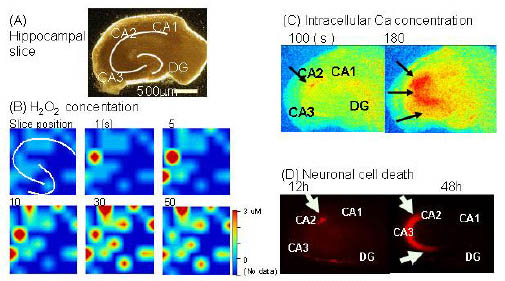Nahoko Kasai, Chunxi Han, Akiyoshi Shimada, Tobias Nyberg and Keiichi Torimitsu
Materials Science Laboratory
Hydrogen peroxide (H2O2) has been recognized in association with the pathology of neurological
diseases because it is a by-product of a degenerative reaction of reactive
oxygen species, one of the major causes of oxidative stress in mammalian
cells. Because it is relatively stable comparing to the other reactive
oxygen species, it has been used as a target molecule for detecting oxidative
stress.
Hippocampus has widely been examined and it is well understood that the
epilepsy relates to the cell death in its specific regions. We have recently
found that by bicuculline (Bic), GABAA receptor antagonist, also causes
neuronal cell death in specific regions in hippocampus [1]. However little
has been investigated on its details.
We have recently established a multichannel H2O2 monitoring system to monitor the real time H2O2 distribution in a tissue. In this study, we examined the cell death caused
by Bic in terms of the oxidative stress [2].
We fabricated the sensor array, and we monitored the real time H2O2 distribution in a cultured rat hippocampal slice placed on the array.
When we introduced bicuculline into the solution as a stimulant, in the
presence of a catalase inhibitor, we could observe a distinct increase
in the H2O2 concentration (B) and increase in calcium influx (C) at the same regions
as neuronal cell death (D). This implies that the Bic causes cell death
through oxidative stress.
This real time H2O2 distribution monitoring system will be a powerful tool with which to explore
the neuronal cell death mechanism in biological systems and to manage the
neuronal disorders.
[1] C. Han, N. Kasai, K. Torimitsu, NeuroReport 16 (2005) 333-336.
[2] N. Kasai, C. Han, K. Torimitsu, Sens. Act. B 107 (2005) 746-750.
 |
||
|